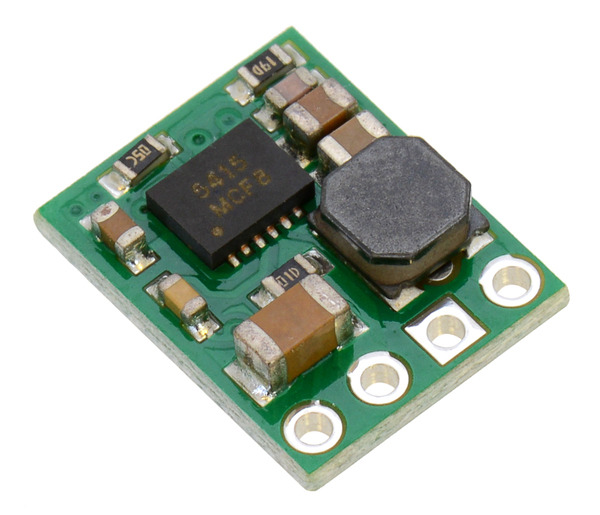Pololu Blog »
New versions of our 500mA D24V5Fx step-down voltage regulators
A few months ago, we introduced our new D24V5Fx buck (step-down) voltage regulator family with inaugural members offering fixed output voltages of 3.3 V, 5 V, 9 V, and 12 V, and now we have expanded that family by adding versions with fixed output voltages of 1.8 V, 2.5 V, 6 V, and 15 V.
We are particularly excited about this regulator family because of its wide operating voltage range, high efficiencies, and low dropout voltages, all in a compact 0.5″ × 0.4″ × 0.1″ (13 mm × 10 mm × 3 mm) form factor that is smaller than standard through hole linear regulators with DIP packages. For example, the picture below shows a D24V5Fx next to a 7805 voltage regulator in a TO-220 package:
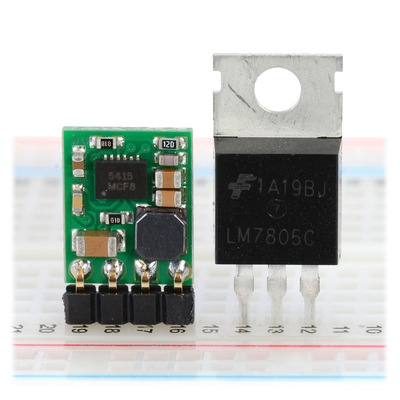 |
These regulators operate at up to 36 V, making them especially useful in applications where there can be large variation in the input voltage, such as solar-powered systems or devices where power supply flexibility is a benefit. Since they are switching regulators, the efficiency is much higher than linear regulators when there is a big difference between the input and output voltage, and since they are synchronous, the efficiency is high even at light loads and low output voltages. As an example of the versatility of these regulators, the same D24V5F2 module can in one application be used to get 2.5 V from a 24 V battery and in another be an efficient way to add a 2.5 V node to a system that already has regulated 5 V. As the performance graph below shows, typical efficiency in the latter scenario is 90%, which could almost double battery life in portable systems when compared to linear regulators.
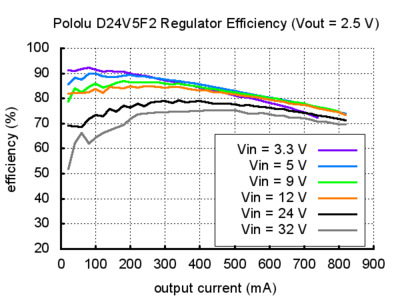 |
We consider the new D24V5Fx regulators to be next-generation alternatives to our D24V3Fx and D24V6Fx buck regulators, which have been some of our most popular products. In addition to having generally higher efficiencies (which in practice allow these 500 mA units to achieve maximum output currents comparable to our 600 mA D24V6Fx units), these new regulators have much lower dropout voltages (“dropout voltage” is the amount by which the input voltage must exceed the output voltage in order to ensure that the target output can be achieved). For example, the two graphs below show the dropout voltage of the new 5 V D24V5F5 compared to the older 5 V D24V6F5 and D24V3F5:
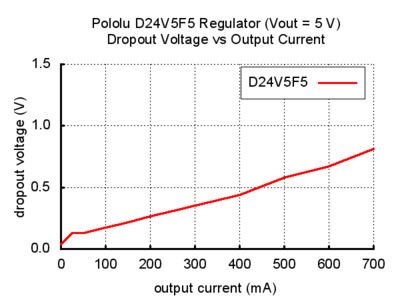 |
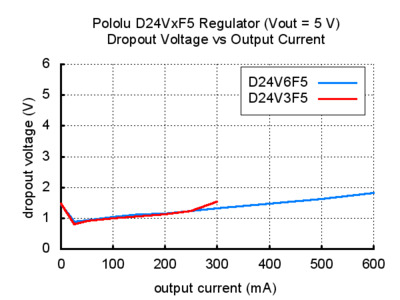 |
What this means for your project is broader operating ranges and longer battery life. For instance, a low-power 5 V system running on a 9 V battery can discharge it all the way to 5 V whereas the higher-dropout D24V6F5 regulator can only go to 6.5 V, and four-cell alkaline and five-cell NiMH packs (both with 6.0 V nominal voltages) become viable options.
For other regulator options, you can take a look at our full selection of step-up voltage regulators, step-down voltage regulators, and step-up/step-down voltage regulators.
8 comments
If you want reverse voltage protection, you should put the diode before the input to the regulator, not on the output. Any diode that can do half an amp and has a reverse voltage rating beyond what you plan to apply should be fine; a schottky type is preferable since it will give you less forward voltage drop.
-Claire
The board has a pull-up resistor between SHDN and VIN, so you can leave the SHDN pin disconnected if you want the board to be permanently enabled. Alternatively, the board can be driven low to put the board into a low-power state and turn off the output.
You can find more information about this in the "Using the regulator" section of the product page for each version of the D24V5Fx step-down voltage regulator. Links to these product pages can be found in the "Related products" at the end of the blog post.
-Brandon
These regulators are enabled by default, and during normal operation at the high ends of their current capabilities they can get hot enough to burn you, so we recommend you take care when handling them or other components connected to them.
- Patrick
I intend to use one of the modules to step down 24V to 3.3V. You recommend connecting an electrolytic capacitor across VIN and GND to prevent voltage spikes when powering module up.
Would so-called "low impedance" 47uF electrolytic capacitor suffice, or do I need to use "normal" one? Could I put a small resistor in series with a capacitor to "compensate" for low impedance, or would it be problematic?
Thank you.
One of the reasons electrolytic capacitors help prevent LC voltage spikes is their relatively high ESR (equivalent series resistance), so a low impedance cap is probably not great. It might just be a marketing term that doesn't mean that much. Adding a small (e.g. 1 ohm) resistor in series should work, as it can for other low ESR capacitors such as ceramics. Our application note about Understanding Destructive LC Voltage Spikes has more information.
-Claire
